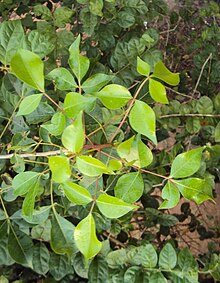Dibatag
The dibatag (Ammodorcas clarkei), or Clarke's gazelle, is a medium-sized slender antelope native to Ethiopia and Somalia.
The upper parts are gray to fawn, while the dorsal and lateral areas are cinnamon to rufous (reddish brown).
Dibatag may maintain temporary territories demarcated by preorbital gland secretions, urine or feces.
Several factors including human settlement, habitat degradation, large numbers of livestock, political unrest and armed conflicts in the areas covering its range and lack of conservation measures for two to three decades in the late 20th century have now reduced the population to only a few thousand.
Some authors such as Rod East of the IUCN SSC Antelope specialist group have classified it under a separate tribe Ammodorcadini.
[3] When Thomas first studied specimens from Somalia in 1891, he observed that the animal seemed to combine the horns of a reedbuck with the characteristic features of a gazelle (muzzle, facial markings, and anteorbital glands).
[3][4] The dibatag, which holds its black tail straight up when it is fleeing,[5] gets its common name from the Somali words for 'tail' and 'erect': dabu and tag.
A chestnut brown streak runs from the crown up to the nostrils along the nose, flanked on both sides by parallel white stripes that circle the eyes.
[6][9] The dibatag closely resembles the gerenuk, with which it is sympatric in eastern and central Somalia and southeastern Ethiopia.
Both are brachyodonts and share several facial and cranial features, along with a two-tone coloration of the pelage and strong thick horns (only in males).
[8] A finer point of difference is the absence of an inward-curving lobe in the lower edge of the ear (near its tip) in the gerenuk.
[9] Sparring is a notable part of fighting behavior: one male pushes and shoves against the neck and horns of the opponent, trying to throw him off balance.
The antelope may even resort to stotting (a behavior particular to the gazelles), a kind of leaping with all four limbs in the air, but this gait is most often used during play.
Predators include the cheetah, lion, spotted hyaena, black-backed jackal, caracal, Cape hunting dog and large eagles.
They often gather in areas with leafy Commiphora stands due to the high water content of their leaves and shoots.
The male dibatag pursues the female; during the march his body is upright and the nose is held high.
[6] A study published in 1972 found a greater number of the dibatag in areas rich in red soil.
[10] The dibatag is endemic to the evergreen bushland of the Ogaden region of southeastern Ethiopia and adjoining parts in northern and central Somalia.
[1] In the northern Ogaden, the animal has become very rare owing to a high density of human settlements and large numbers of armed pastoralists and their livestock.
However, in the southern Ogaden, it is still common due to greater wealth of natural flora and fewer human settlements.
In Somalia, conservation measures have been hindered by lack of political stability due to conflicts over two to three decades in the latter half of the 20th century.
[11] However its brown pelage and alertness and timidity make hunting for it in dense bushes considerably difficult compared to other antelopes.
No population estimates or surveys could be made in the three decades from the 1960s to the 1990s due to political unrest and armed conflicts in the areas covering the range.
[1] The scenario is grim in Somalia: the dibatag have been overhunted, and their habitat faces destruction due to farming practices such as livestock grazing.
Though locals claimed to have seen it in the central coastal hinterland even in the late 1980s, no clear surveys have been conducted since then to support this.



